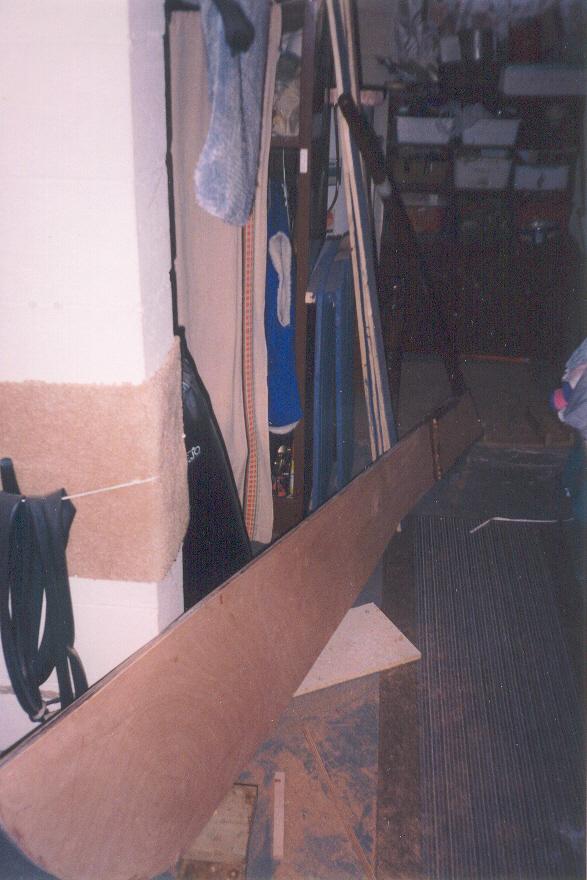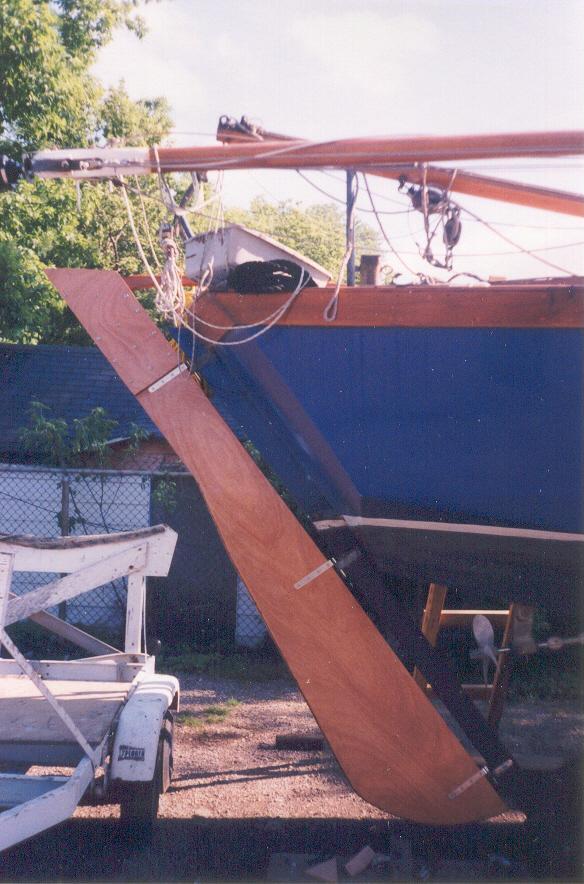Weights, clamps, and vise-grips while the epoxy set.
The next day, after the epoxy was set and the weights removed.
Building a New Rudder for "Belle Argo"
|
Summary: Making a new rudder for an old wooden boat (Dickerson 32' Aft Cockpit Ketch) out of marine mahogany plywood and epoxy. You may want to check out our Selected Books section under the DIY and Projects category for books covering boat projects and renovations that you can do yourself.
|
When I purchased Belle Argo, a Dickerson 32 Aft Cockpit Ketch, in 1999, she didn't have a rudder. The previous owner had lost it while sailing when it was lifted off it's gudgeons by a wave, and he wasn't able to retrieve it. It spent the remainder of the previous season with a 2x6 pine board to which some plywood had been fastened for a rudder, so building a new one was one of the first priorities.
I never saw the original rudder, so didn't really know what it was supposed to look like, and I couldn't find any Dickerson-specific information on it, so I set about designing a shape on my own.
I eventually settled on a shape with a rounded lower end so that it wouldn't be damaged if I ran aground - the rudder post would most likely take the impact, and the rudder wouldn't get jammed into the ground when backing off.
I bought a 3/4" 4x8 sheet of marine grade mahogany plywood, traced out the shape twice, cut the pieces, and glued them together using WEST System epoxy. I didn't have anywhere near the number of clamps I'd have liked to have had, so resorted to using a variety of barbell weights to put pressure on it.
|
Weights, clamps, and vise-grips while the epoxy set. |
The next day, after the epoxy was set and the weights removed. |
Once the two pieces were glued together, I used a router to round the trailing edge of the rudder. The leading edge was left square as it would be attaching to the rudder post, which was a hunk of oak (I believe) with approximately 2x4 dimensions.
The next step was to build the upper box that would accept the tiller handle. This was also made from the marine mahogany plywood and was both glued and screwed together for strength. Once completed, the whole rudder was coated (painted, really) with thinned epoxy, the idea being that the thin epoxy would penetrate the wood and, once cured, would protect it from the elements.
|
Tiller box is complete and it seems to fit!
|
 |
The rudder after having been coated in thinned epoxy. |
Basically, after that, it was a matter of putting the pintles on (measure twice, pray, measure again, and then drill the holes) to match the rudder post's gudgeons, hang it on the back of the boat, varnish the upper part and prime and anti-foul the bottom. Of course, I included a stopper so that it couldn't be lost at sea again!
The rudder served well for the years I owned the boat and didn't suffer any ill effects from being submerged for months at a time. If I had to do it again, I'd give it a bit more breadth at the lower end in front of the propeller wash to help with close-quarters steering, but it performed well enough, and was easy enough on the helmsman that I was happy with it.
|
A 9' rudder in their living room equals patient parents. |
 |
A waterline stripe and some antifouling, and we're ready to go! |
© Copyright 2008
David S. Malar and Angelika Jardine. All rights reserved.
Home -
www.selfmadesailor.com
Website Design and SEO (Search Engine Optimization) by VentureIT.ca